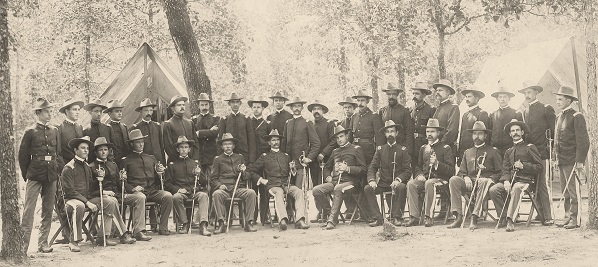


The Sixth Regiment, United States Volunteer Infantry, also known as the "Sixth Immunes," served its term of service in the continental U.S. and in Puerto Rico.
The Unit History:
The Sixth United States Volunteer Infantry was one of ten volunteer infantry regiments authorized by the President McKinley during the Spanish American War. Of the ten regiments, the first through the sixth were units composed of white infantrymen and the seventh through the tenth regiment were composed of African American infantrymen. The Immunes were, by their own admission upon signing, stating that they believed that were immune to yellow fever because they have had the disease previously or for some other reason.
The “Sixth Immunes,” the more common name for the men of the Sixth United States Volunteer Infantry, were mustered into service between June 24, 1898 and July 15, 1898 at Camp Wilder in Knoxville Tennessee. Camp Wilder was named after Civil War Brigadier General John T. Wilder, who commanded the “Lightning Brigade” at the Battle of Chickamauga. Wilder was a businessman in Chattanooga at the time of the Spanish American War. The majority of the recruits came from Tennessee, Kentucky, and as far away as Ohio. The unit consisted of 46 officers and 904 enlisted men at the time of mustering in.
The regiment was commanded by Colonel Lawrence Davis Tyson, an 1883 graduate of West Point Military Academy, veteran of the Apache Indian wars, and professor of military tactics at the University of Tennessee.
The men did not stay at Camp Wilder for long and on July 30, 1898 the regiment was ordered to proceed to Camp Thomas. Camp Thomas was an encampment on the grounds of Chickamauga Park, the site of the Civil War battle near Chattanooga, Tennessee. At Camp Thomas, the regiment was assigned to the Second Brigade, First Division of the Third Army Corps. At the time of arrival of the 6th U.S. Volunteer Infantry, Camp Thomas was in the worst condition possible. The Camp had rapidly grown to a city of over 30,000 men with inadequate supplies and sanitation. Disease and illness were rife. Amid public outcry, various regiments began to be removed from the Camp beginning in late July, relocated north and to other “healthier” camps. The 6th, however, would remain. Also, while the regiment was at this camp, on August 12, 1898, an armistice was reached between the U.S. and Spain, ending the war’s fighting.
The regiment was encamped at Camp Thomas until October 6, 1898 when it was ordered to proceed to New York to embark for San Juan, Puerto Rico. The Sixth was to serve as an occupation force on the island and relieve the Sixth Massachusetts Volunteer Infantry. On October 9 the Sixth U.S. Volunteer Infantry embarked on the transport MISSISSIPPI for the six day voyage to San Juan.
Upon arrival at San Juan, the Sixth was broken up by companies and sent to various cities in Puerto Rico, with portions of the regiment serving at Arecibo, Manati, Dorado, Isabela, Lares, Bayamon, Utuado, Barcelonita, Toa, Alta and Camuy. The regiment’s commanding officer, Colonel Lawrence D. Tyson, served as Military Governor of the island for a period. The Sixth United States Volunteers served in Puerto Rico from October 15, 1898 until February 12,1899 when they were ordered back to the continental United States. The Sixth Immunes returned to the United States on February 18, 1899 aboard the transport CHESTER and went into camp at Savannah, Georgia. While the regiment was serving in Cuba, the Treaty of Paris was signed, officially ending the Spanish American War.
The Sixth United States Volunteer Infantry, with an overwhelming majority of officers and enlisted men, sought to be retained in service but was unsuccessful. The regiment was mustered out on March 15, 1899 at Savannah Georgia.
At the time of mustering out the regiment consisted of forty-six officers and Eight hundred seventy-three enlisted men. During their term of service, the Sixth United States Volunteer Infantry lost eight officers due to resignation or discharge. Enlisted losses include three transferred, sixteen discharged for disability, two discharged by general court martial, forty discharged by order and thirteen deaths due to disease.
Correspondence relating to the War with Spain And Conditions Growing Out of the Same Including the Insurrection in the Philippine Island and the China Relief Expedition. Vol. 1 (Washington: Government Printing Office, 1902) 626-627.
The Knoxville Journal and Tribune. (Knoxville, Tennessee 1898).
Rootsweb.com -Spanish American War Camps http://www.rootsweb.com/~necivwar/SpanishAmericanWar/span_am_camps/pg14.htm#wilder
Statistical Exhibit of Strength of Volunteer Forces Called into Service During the War with Spain; with Losses from All Causes. (Washington: Government Printing Office, 1899).